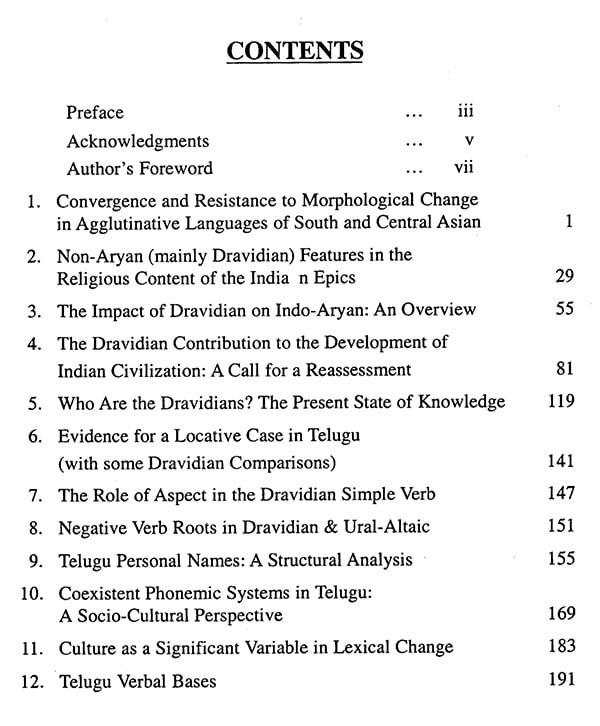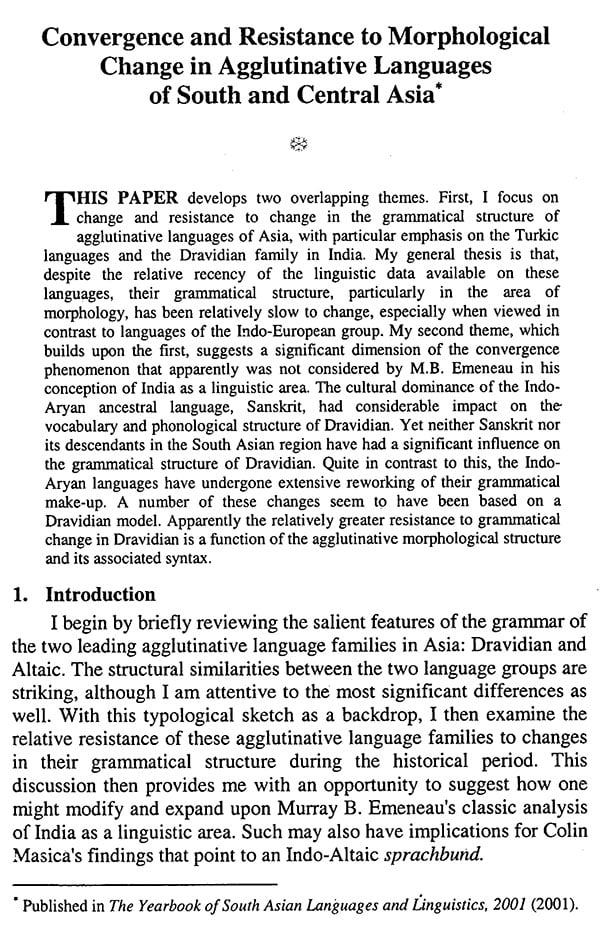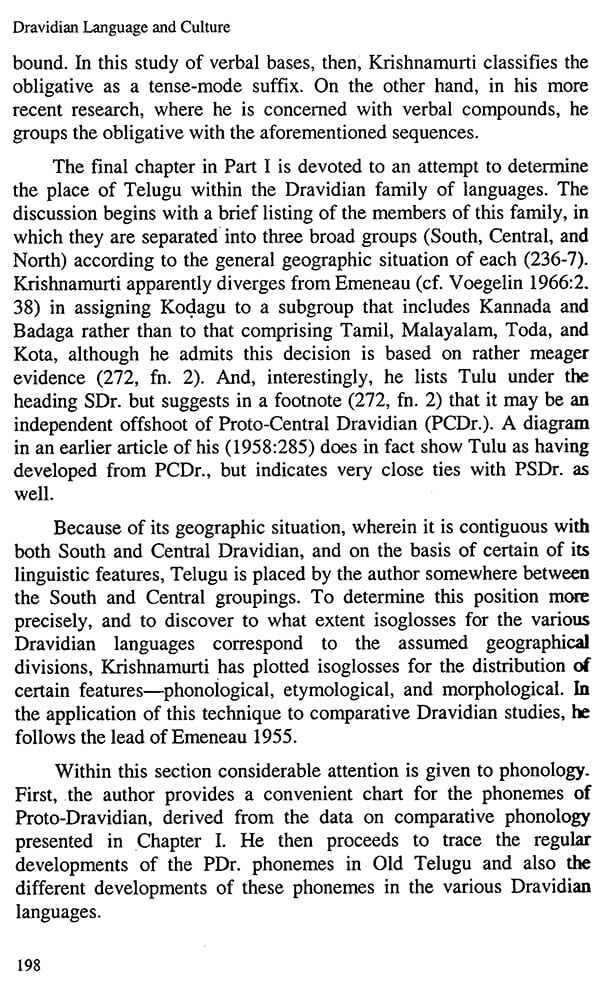
Dravidian Language and Culture
Book Specification
| Item Code: | NAX099 |
| Author: | Andree F. Sjoberg |
| Publisher: | Dravidian University Campus |
| Language: | English |
| Edition: | 2009 |
| Pages: | 202 |
| Cover: | PAPERBACK |
| Other Details | 9.00 X 6.00 inch |
| Weight | 290 gm |
Book Description
Andrée F. Sjoberg was born in New York City in 1924. She earned a B.S. degree in geology from the University of New Mexico in 1947 and an M.A. degree in anthropology in 1951 from the University of Texas at Austin. In 1957 she was awarded the first Ph.D. degree in the new linguistics program at the University of Texas, writing her doctoral dissertation on the influence of Sanskrit on the phonology of Telugu under the direction of Winfred P Lehmann, who went onto become a world-renowned linguist.
She began her teaching career in 1960 in the newly established Hindi-Telugu program that later became part of the newly formed Department of Linguistics at the University of Texas. During the next decade or so she taught courses on Telugu and eventually Malayalam, as well as a number of topics in linguistics. She then served as Associate Professor in the Department of Oriental Languages, later to be named Asian Languages, and until her retirement in 2000 she taught courses on the four leading Dravidian languages, as well as Turkic language and culture and a number of broad-based survey courses on Asian Culture.
In addition to her work on Dravidian studies she carried out research on Uzbek, the leading Turkic language of Central Asia, writing A Structural Grammar of Uzbek (1963), which formed part of the Uralic and Altaic Series published by Indiana University. This background knowledge led her to pursue further research on agglutinative languages in Asia, including Dravidian.
Dr. Sjoberg’s longstanding interest in cultural history, evidenced in some early articles that she published on historical ethnology (on several American Indian groups in Texas, as well as Uzbeks in Afghanistan), led her to a deep interest in the role of the Dravidian-speaking peoples in the development of Hinduism and traditional indian culture. She spent a year in India in 1965-66 and nine months in 1972 carrying out linguistic research. She visited India for shorter periods on a number of other occasions, was an invited guest at the Second World Telugu Conference in Kuala Lumpur in 1981, and in 1996 participated in the groundbreaking ceremonies for the Dravidian University in Kuppam, A.P. She has been married since 1947 to Gideon Sjoberg, who is Professor of Sociology at the University of Texas at Austin.
That the foundations of Indian culture were deeply embedded in Dravidian culture is now an incontrovertible fact. Dravidian culture is one of the most ancient cultures of the world. Those cultures, slightly contemporaneous to one another, slowly started fading out. However, the primordial Dravidian culture continues to thrive without losing its quintessence despite the apparent changes in systems of dress and address.
Dravidian University was established in 1997 to mirror the real and rich picture of Dravidian culture not only in its linguistic, literary, cultural and philosophical facets but in science and technological angles also.
At a time when no special attention worth its name was paid by the Centre with regard to language, the Southern states except Kerala, had established all by themselves their own Universities - Telugu, Tamil and Kannada to research on their languages and cultures.
The Government of Andhra Pradesh took a step ahead and started Dravidian University, with the co-operation of the sister states, to research and reflect on the inherent oneness of the cultures of the four I states whose languages number up to 27. Its endeavour is to promote I unity and amity in the family of several languages. The main I objectives of Dravidian University are to augment the common weal . ' and social well being of the communities of marginal languages and to build bridges among the Southern states. While working on each language separately in varied areas, it aims at a synthesis and a discovery of the common heritage through Comparative Studies.
Prasaranga (Publications wing) and Anusrjana (Translation Bureau) are the two most significant wings of the University from out of its several on going progressive activities.
Among the scholars that have richly contributed to the Dravidian Studies Andrée F. Sjoberg is the prominent one. She did path breaking research on Dravidian Languages. One can identify her work with that of the pioneers in the discipline. Love for Dravidian languages and linguistics is conspicuous on her writings. Her observations, with regard to Dravidian Language and Culture are revelatory. She says in one of her articles "my central thesis is that the Sanskrit epics the Ramayana and Mahabharata (particularly the chapters that make up the Bhagavad-Gita) are in their religious — philosophical content more non-Aryan (and, specifically, Dravidian) than they are Aryan’. Unless one has thorough knowledge and required data one cannot make such observations. With all authenticity she establishes the non-Aryan contribution for the formation of Indian civilisation. She even shows the Dravidian impact on Hinduism. She explains how the little tradition specifically in the Dravidian region preserves certain patterns like godworship, snakeworship and cattle rituals.
I am happy that our university is publishing her papers that deal with Dravidian languages and culture. Every paper included in this anthology ‘Dravidian Language & Culture’ reflects her expertise in her chosen domain. Publication the books like the present one fulfils the primary objective of the Dravidian University.
I wondered at the meticulous care that Prof. Sjoberg has taken in preparing the papers for publication. It reflects her dedication for the Dravidian Studies. I sincerely thank Prof. Sjoberg, a scholar of international eminence, for giving her work for publication to the Dravidian University. I congratulate Dr. D. Balaganapathi for the interest shown by him in getting this book from Prof. Sjoberg and compiling it. I hope that this work will enhance the spirit of the ~ scholars, working in Dravidology, for undertaking further research in the field.












